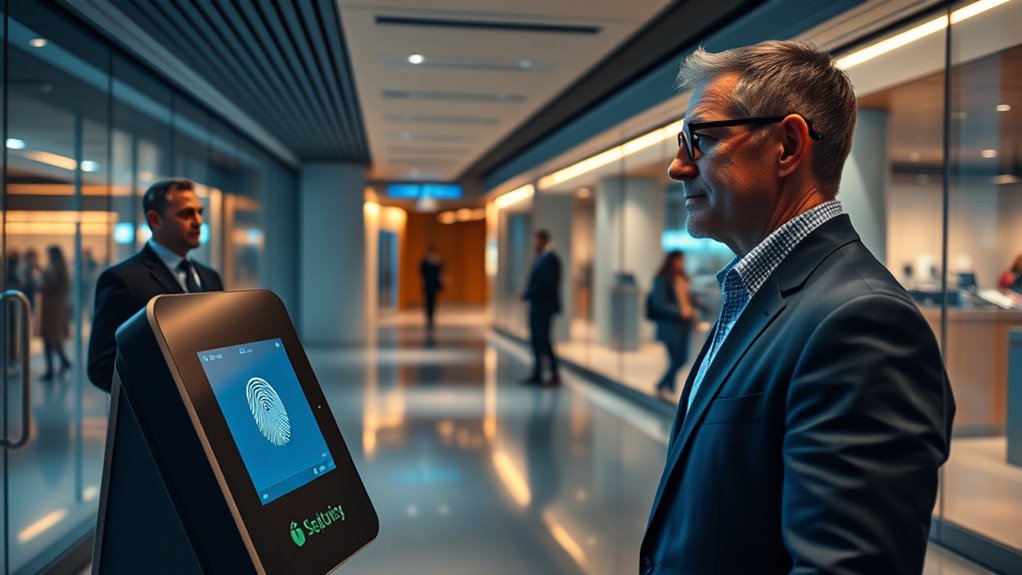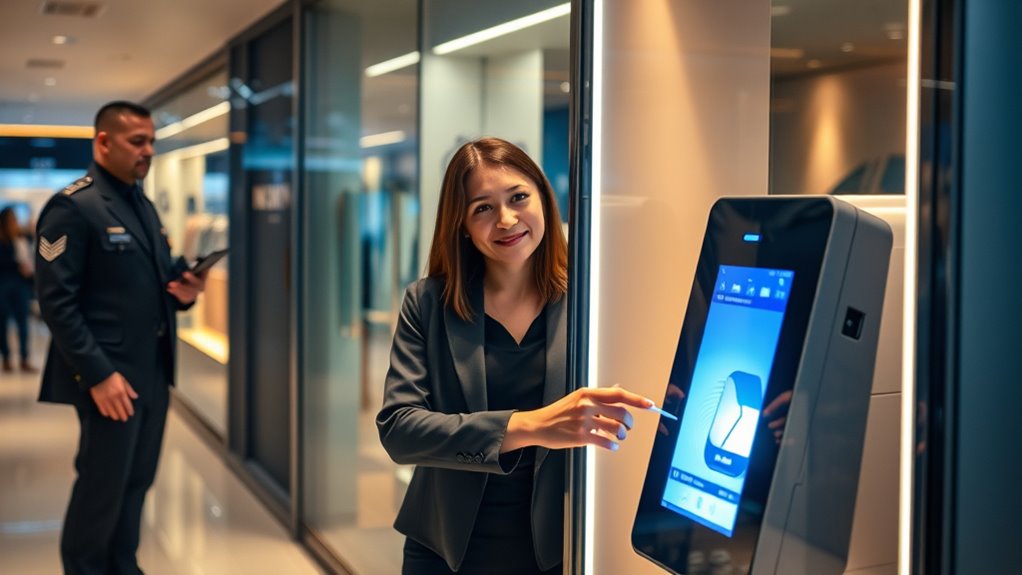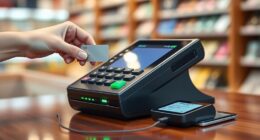Finding the right balance between security and convenience means understanding your customers’ priorities. Most consumers want both simplicity and protection, but they often prefer quick, frictionless experiences, especially for social media or financial services. Overly strict security can frustrate users and cause lost sales, while weak measures can erode trust. Smart, adaptive solutions—like biometric authentication and tailored security—help you protect customers without compromising their experience. Keep exploring to discover how you can optimize this balance effectively.
Key Takeaways
- Implement adaptive security measures tailored to customer segments to balance fraud prevention with seamless access.
- Use biometric authentication for frictionless, secure login experiences that build consumer trust.
- Streamline multi-step authentication processes to reduce cart abandonment and enhance user satisfaction.
- Leverage data analytics to customize security protocols without compromising convenience.
- Continuously innovate security solutions to protect transactions while maintaining effortless customer journeys.

Balancing security and convenience is a challenge many online consumers and businesses face today. Most consumers prioritize security—74% rank it as their top concern when browsing or transacting online. Yet, they also value convenience, often placing it just behind security in importance. Surprisingly, despite their emphasis on safety, 87% of consumers still prefer convenience over security during social media discussions about financial services. This shows that, in practice, ease of use often trumps strict security measures, especially when users encounter complicated procedures. Nearly 30% of consumers prioritize simplicity and quick access over security, highlighting a clear tradeoff. When security measures are too burdensome, many abandon transactions, costing businesses revenue and frustrating customers.
Most consumers prioritize security but prefer convenience, often abandoning transactions when security measures become too burdensome.
High-security protocols like Strong Customer Authentication (SCA) are designed to protect accounts, but they can also create friction. For European businesses, implementing SCA sometimes results in up to 20% fewer completed payments. Customers may find multi-step authentication processes cumbersome, which discourages purchases and increases cart abandonment rates. Password resets add to the problem, accounting for as much as 6% of call center volume—costing companies millions annually. Calls for identity verification consume additional 5-10% of call center time, further inflating operational costs. Streamlining authentication without compromising safety is essential. When done right, it reduces customer hassle and cuts costs, creating smoother experiences and freeing up resources.
Consumers are willing to share more personal data if they see tangible benefits like improved security or convenience. About 70% say they’d share more if it meant better protection or easier access. Trust in biometric authentication has surged; confidence in using fingerprint or facial recognition jumped from 43% to 74%. This indicates that innovative tech can bolster trust while enabling seamless login experiences. As fraud prevention budgets increase, organizations recognize the importance of balancing security with user convenience. Customers expect both, and delivering on this creates a stronger relationship rooted in trust. Recent surveys also show that 65% of consumers are more likely to complete purchases if they experience minimal security friction.
Emerging technology trends reflect this shift. Consumers want on-demand services that are quick and simple, which challenges traditional security models. Security conversations tend to spike after breaches or hacks, but maintaining convenience remains a steady focus in customer interactions. Data analytics help businesses tailor security measures to different customer segments, optimizing the balance between safety and ease. New authentication methods, especially biometrics, can prevent fraud while offering frictionless access. Managing risk without disrupting seamless customer journeys is key to thriving in today’s digital marketplace.
Businesses face tough choices in this balancing act. Overemphasizing security can lead to lost transactions and customer dissatisfaction, while prioritizing convenience risks fraud and eroding trust. Companies must carefully segment customers and adapt security measures accordingly. Achieving the right mix involves continuous innovation and strategic investments, ensuring safety without sacrificing the smooth, effortless experiences consumers now demand.
Frequently Asked Questions
How Can Small Businesses Improve Security Without Sacrificing Customer Experience?
You can improve security without sacrificing customer experience by adopting frictionless measures like biometrics or risk-based authentication. Use real-time monitoring to detect suspicious activity quickly, minimizing disruptions. Communicate your data protection efforts transparently to build trust, and regularly test your security features to identify pain points. By integrating seamless security solutions, you protect your business while ensuring your customers enjoy a smooth, secure shopping experience.
What Are Emerging Technologies That Balance Security and Convenience?
Emerging technologies are making it easier for you to stay secure without sacrificing convenience. You can use AI-powered behavioral biometrics to verify users seamlessly, while cloud-based identity management offers quick, secure access across devices. IoT security solutions with blockchain and lightweight modules protect data at the source, and advanced IAM like passwordless and biometric authentication streamline login processes. These innovations help you balance robust security with a smooth customer experience.
How Do Cultural Differences Influence Security and Convenience Preferences?
Cultural differences shape how you prioritize security and convenience. In individualistic societies, security measures like multi-factor authentication are essential, as people value privacy and control. In collectivist cultures, you might accept more shared information for easier transactions and community trust. Knowing these preferences helps you design tailored security policies, ensuring your customers feel safe without sacrificing the seamless experience they expect, respecting their cultural norms.
What Role Does Customer Education Play in Fraud Prevention?
Customer education creates confidence, clarity, and control, vital for combatting fraud. By learning to recognize scams, slow down, and stay skeptical, you’re better equipped to resist risks. When organizations actively educate, you get empowered, informed, and engaged. This proactive approach not only prevents fraud but also promotes trust and transparency, making your experience safer and smoother. Ultimately, educated customers are essential allies in fighting fraud and fostering lasting loyalty.
How Can Companies Measure the Effectiveness of Their Security Measures?
You can measure the effectiveness of your security measures by tracking key metrics like your Mean Time to Detect and Respond (MTTD and MTTR), which show how quickly you identify and neutralize threats. Keep an eye on your incident response success rate, false positive rate, and number of threats detected. Monitoring vulnerability remediation times and the percentage of patched critical systems also provides insight into how well your security efforts are working.
Conclusion
Remember the tale of Pandora’s box—you can’t have both security and convenience without risking chaos. Striking the right balance is like walking a tightrope; too much security stalls your flow, while too much convenience leaves you vulnerable. By thoughtfully integrating smart technology and user-friendly practices, you can create a seamless experience that’s as secure as a fortress. Ultimately, it’s about finding harmony—because in the end, a well-guarded but effortless customer journey is the true treasure.









